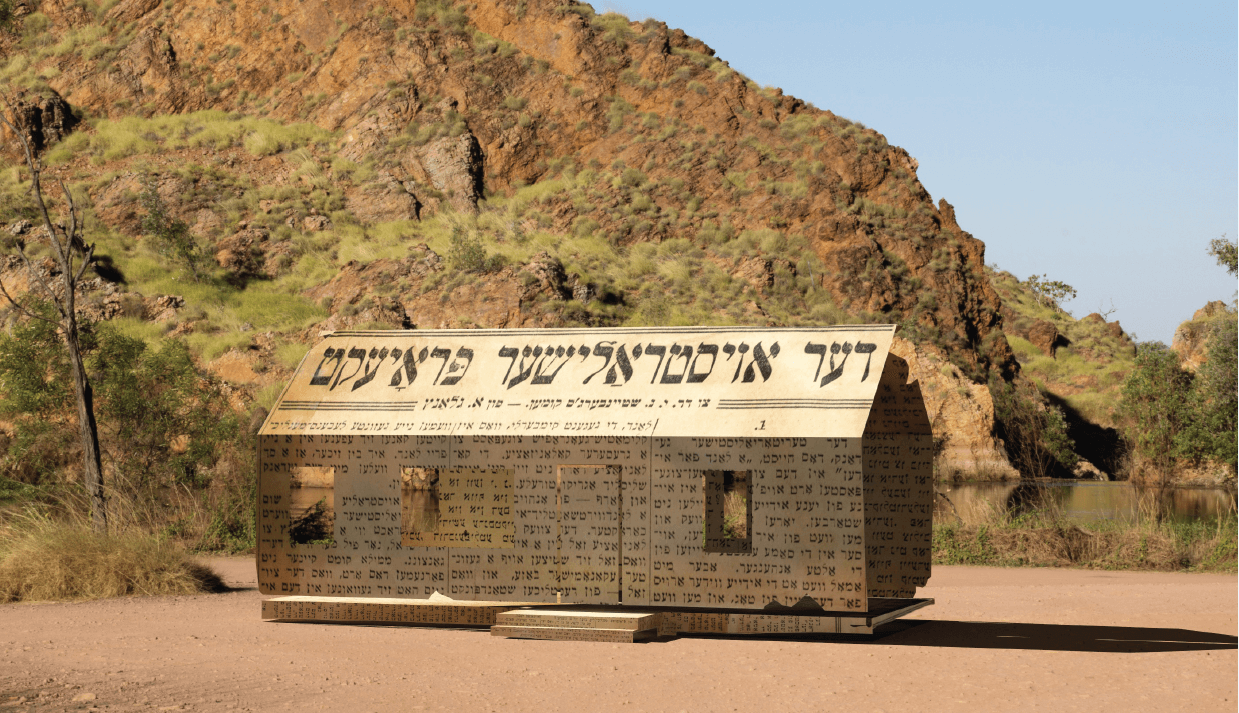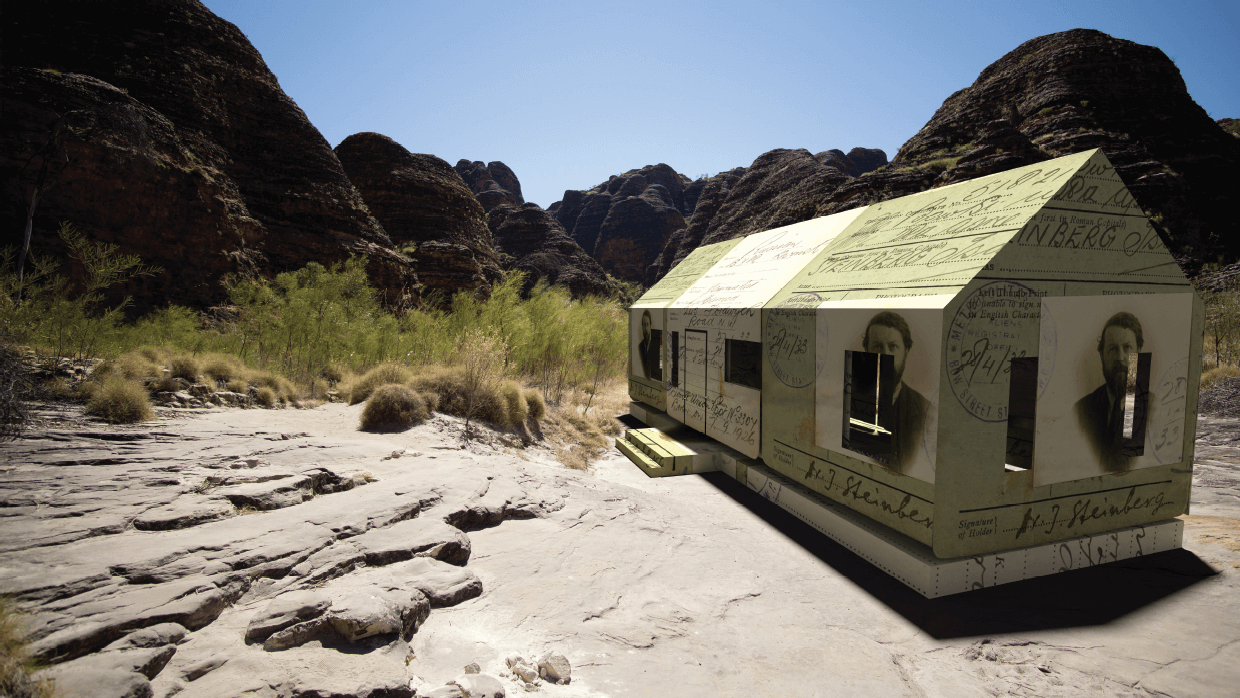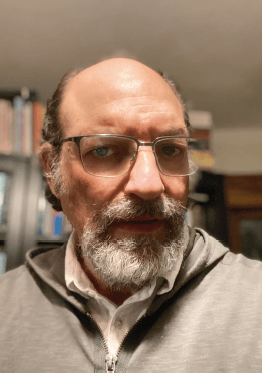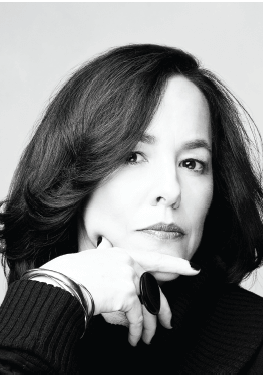Above: Detail from Archie Rand. 326: To Send the Impure from the Temple (Numbers 5:2), 2001-2006. From the series The 613. Acrylic on canvas. 20 x 16 in. Photo by Samantha Baskind
Artist–Scholar Collaborations

Fig. 1. Courtesy of the artist
Let us begin with the following counterfactual question— what if Jewish Territorialist leader I. N. Steinberg (1888– 1957) and his organization The Freeland League had instituted its proposed Kimberley Plan by purchasing millions of acres from the pastoralist Michael Durack in western Australia in the late 1930s, thereby saving Jewish lives before the Holocaust? Utilizing digital media (including the software programs Rhino, 3D Studio Max, and Photoshop) that are applied to the material traces of an alternative Jewish history, this project models and renders nothing less than an imaginary Jewish homeland situated in the Australian outback. From the rugged look of the landscape, we are quite far from the European shtetls and yet Yiddish appears to be spoken here (fig. 1). The Yiddish headline running along the paper house in the first FREELANDscape informs us what it was all about when we translate it as—“The Australian Project.” In contrast to Theodor Herzl’s Zionism that fixated on the return of the Jews to the ancestral Land of Israel as the promised location to build a modern nation-state, the Freelanders rather advocated cultural autonomy alone and concentrated their efforts on settling uninhabited land wherever it was available on the globe. That is why this article by A. Glantz begins with a reference to what the author calls “territorialist thought” summarized succinctly as “A Land for Jews.”
“The Imaginary Jewish Homelands of I. N. Steinberg” is a collaborative research-creation project supported by an Insight Grant of the Social Science and Humanities Research Council of Canada. Like many contemporary works that make art through the excavation of archival or museum collections, the project reanimates and repurposes original documents (e.g., newspapers, letters, memos) found in the voluminous Papers of Isaac Nachman Steinberg housed at the YIVO Institute for Jewish Research in New York. In this example, a yellowed and fraying newspaper clipping is transformed into a three-dimensional house. This process combines in its construction the architectural modeling program Rhino with the subsequent texturing of the model in Photoshop. The house is replete with perforated door and window openings that allow for greater transparency—and for more fresh air and sunlight—but these cutouts also interrupt our reading of the original article in those places. In direct contrast to George Steiner’s famous Jewish diasporic dictum of “our homeland, the text” for the people of the book, what we find here is not so much a textual homeland but rather the construction of homes for Jewish refugees that are made out of texts. Thus, the motto for FREELANDscapes would be “our homes, the texts” as we imagine a Jewish homeland in the Kimberley landscape. Featuring surreal juxtapositions, the series pairs these houses with landscape photographs that were shot on location during our fieldwork as we traversed the very places that would have become a Jewish settlement if Steinberg’s bold and idealistic project had come to fruition. Thus, what makes Melissa Shiff’s picturesque image partake of the character of photomontage is the fact that this imaginary paper house has been transplanted and superimposed onto the breathtaking landscape of the Kimberley. The placement of this Yiddish house with direct access to a body of water behind it is also an important marker that recalls Steinberg’s prescient advocacy of irrigation and the construction of man-made lakes for agricultural success in the region.

Fig. 2. Courtesy of the artist
The other FREELANDscape (fig. 2) consists of a photo-portrait of Steinberg who peers out in triplicate as if looking out the window of his green and white paper house at the foot of an imposing and impressive black rock formation.
This lack of a permanent place to call home is also what makes the juxtaposition of this piece of identification so powerful and poignant as it becomes the building block for a paper house located somewhere in the remote Australian outback.
What is the source of the official document used for this digital model and how does it comment on photography in general? Upon closer inspection, it is dated April 28th in that fateful year of 1933. In a stroke of good fortune, Steinberg left Berlin (where he was already in exile from the Soviet Union) on a trip to the United Kingdom on January 27th (the date is also visible in the central panel), but this also meant that he had no place to go after the Nazis seized power three days later. Signed in his own hand and with an official stamp, this Alien Registration Certificate allowed Steinberg to stay in London as a political refugee. Now it is well known that photography functions as a discourse of identification and that its categorical imperative demands that we keep our papers in order. This shows up on official documents such as the passports of nation-states. The point here is that while this refugee’s certificate references the Soviet Union, Germany, and the United Kingdom, none of them offered “a land for Jews” and that is why Steinberg undertook his political mission in Australia six years later. This lack of a permanent place to call home is also what makes the juxtaposition of this piece of identification so powerful and poignant as it becomes the building block for a paper house located somewhere in the remote Australian outback. In other words, Shiff’s photomontage drives home the point that this charismatic political organizer travelled to the Kimberley with the vision that it would be the place to forge a new Jewish identity (and identity papers).
What if the Freeland League had succeeded in its goal of finding a refuge for persecuted Jews somewhere in Australia? These FREELANDscapes conjure a vision that matches I. N. Steinberg’s fantastic Kimberley scheme but that also marks its failure (and the gap between the real and the ideal). The fragile paper refugee houses of this digital art project underscore the idea of a Jewish utopia that unfortunately crumbled, while offering the viewer an opportunity to learn more about alternative homelands and Jewish counterfactual histories beyond the Land of Israel during the twentieth century.

LOUIS KAPLAN is professor of History and Theory of Photography and New Media in the Graduate Department of Art History and an affiliated faculty member at the Anne Tanenbaum Centre for Jewish Studies at the University of Toronto. He collaborated with Melissa Shiff on the Mapping Ararat project (www.mappingararat.com) and is the co-principal investigator for “The Imaginary Jewish Homelands of I.N. Steinberg.” His latest book is At Wit’s End: The Deadly Discourse on the Jewish Joke (New York: Fordham, 2020).

MELISSA SHIFF is research associate at the Sensorium Research Centre for Digital Art and Technology at York University, Toronto. Her artistic practice has focused on Jewish themes for over two decades (both reinventing Jewish rituals and reanimating Jewish archives). Her work is in the permanent collection of the Jewish Museum in New York and she was the commissioned artist for two exhibitions celebrating the centennial at the Jewish Museum of Prague. She is principal investigator for “The Imaginary Jewish Homelands of I.N. Steinberg,” supported by a SSHRC Insight Grant. Website: www.melissashiff.com.